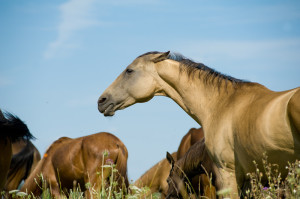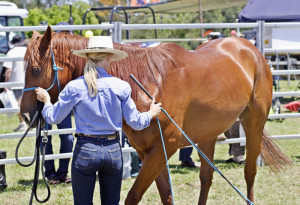Whether your ‘herd’ is comprised of thirty horses or just one, learning how to be the leader will make you, and them, much happier.
Unlike humans, who are predators, horses have a collective ‘herd understanding’. The intrinsic desire to cooperate and get along with others ensures their survival in the wild. Each herd, or band, of horses develops a ranking order. That order must be re-organized each time a new herd member is introduced.
All you have to do to observe this in action is watch a herd of horses in a pasture. It will become apparent who the leaders are by their body language (more on this later). The leader is guaranteed the best food and shelter, but also has the responsibility to alert the rest to danger and watch for signs of change in their environment. Enter the new horse. Now, the entire herd must re-establish their ranking, based on really nothing more than posturing. Those who command space most effectively are herd leaders. Those who must defer are followers.
As long as each horse knows its place in the herd, everyone is happy. Those who are followers lead mostly content lives. After all, they don’t constantly have to defend their place in leadership. They don’t have to stress about getting fed first, because they know to wait. Peace reigns in the herd.
In order to be an effective leader to your herd, you must think like a horse. Horses use non-verbal cues to let others know they are in charge. Direct eye contact, marching purposely forward into another’s space, snaking the head, pinning the ears, and making others move away are all loud and clear messages to the lower-ranking horse. If these don’t work, the leader may resort to showing teeth or posturing to kick (seldom do these behaviors actually connect with others, except in play).
Herd leaders are satisfied once the others move away from space, food, or another horse. They quietly return to eating and peace is once again established in the herd.
Contrast this to humans. When we don’t get our way, we often resort to flailing our hands (the paws of a predator in your horses’ mind) or yelling and screaming. Since horses don’t lose control in this way, they become fearful of the out-of-control predator in their midst. They also don’t respect you, since you clearly don’t have calm control of the situation. You cannot expect them to trust you if you behave in this manner.
We also sometimes allow our horses to push us around, pull us at the end of the lead rope, or invade our space by shoving, biting, or turning their haunches to us. Because we are predators, we react by acting like predators and becoming aggressive.
Your horse is uncomfortable with anger, fear or aggressiveness on your part. Benign and calm leadership makes him feel safe. Safety is the most important thing to your horse – even more important than food or his other herd members. These are prey animals that worry constantly about being eaten, even though domestication has largely removed that threat from their lives.
So, how do you convey leadership in a way your horse will understand?
- Check your ego at the barn door. Leave your human expectations behind. Your horse is not trying to make you ‘look bad’ or intentionally trying to annoy you. He is merely behaving like a horse.
- Never lose your temper or think in terms of ‘punishment’. It is a calm, measured ‘correction’
- Be very fast. If your horse pushes you, instantly push back harder. If you wait, you have lost the opportunity and your horse will not understand.
- As soon as your horse gives you the desired behavior, it becomes a ‘new day’. Do not harbor resentment – let go of the infraction as soon as you establish your leadership. Leaders don’t continue to pick at others.
- Speak your horses’ language. Many a fractious young horse has been slowed down by his human using the ‘mare glare’- a whipping around of the head with an intense stare. You can’t pin your ears, but you can think it. Similarly, horses who have developed the habit of threatening to kick (picking up a hind leg and pinning their ears) when something doesn’t go their way can often be stopped immediately by you turning your own butt toward your horse and lifting your leg as if to kick. (obviously you are not actually going to follow through)
- Smile when you establish leadership – do so quietly and with good humor, and know you are in charge. Be silently amused that your horse is acting like a recalcitrant child.
- Have a mental picture of the correct outcome.
- Fearful or reactive horses are the most dangerous. Try not to react when your horse leaps dramatically out of your way after you simply ask nicely for him to move. Speak in soft, soothing tones. Move slowly and deliberately – and be matter-of-fact going about your business. Pretend you didn’t notice his drama. He’ll learn not to react from your own lack of reaction.
- Use only as much force as necessary. If you ask your horse to move over, for instance, and he acts as if he hasn’t heard you, you can poke him annoyingly in the side with your finger while you say ‘over’. He will want to move away from the ‘annoyance’ and as soon as he begins to, stop and stand quietly. Praise him. Ultimately, your horse should move over with a light, gentle touch on your part and the word ‘over’.
- People often want to coddle rescue horses and allow them to behave badly because they want the horse to know they are loved and safe. This is the worst thing you can do! Be loving, yes. But ensuring your horse has fair boundaries, behaves respectfully toward you, and is not in charge will make him feel much safer – and will do so sooner. Loving behaviors are grooming, hand grazing, standing quietly next to your horse and rubbing his withers or running your fingers through his mane.
- Although your horse can learn words, it is your tone, volume and intent that get the message across. Use this to your advantage. Your horse will learn that you move slowly and deliberately, speak softly and caress him when he is behaving properly.
- If your horse forges at the end of the lead rope, quietly stopping and making him back up a few steps each time will often solve the problem.
- Learn to read your horses’ facial expressions. While each horse is unique, they all have an array of facial expressions which hold meaning. Pinning the ears is a universal way to express displeasure. Some horses upper lip extends when they are upset. Some get a ‘tight’ look to the mouth. Others tighten their jaw when stressed. Know your horse.

The key is to understand your horses’ body language and speak to him in a way he comprehends. We have just touched on the basics here – it’s one of the reasons experienced horse owners love the interaction with their equine friends – we always has more to learn from them.
Have a ‘toolbox’ ready with many tools to address any issues you may encounter. This is true for handling your horse on the ground and when riding. Adjusting quickly to stop your horses undesirable behavior and just as quickly rewarding good behavior means you can go on to enjoying your time with him much sooner. You’ll both be much happier.

